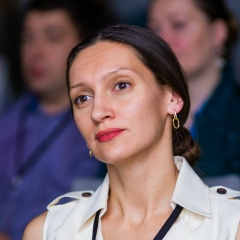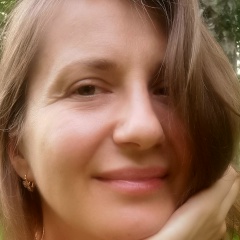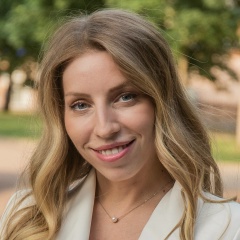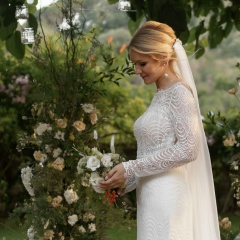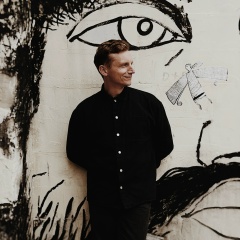Я давно не писала, но у нас все в порядке: в четверг был 6-й день Лесиного курса. О нем и расскажу.
На этот раз изучали овощи. Светику наши занятия нравятся, и он часто присоединяется. Теперь я понимаю, почему считается, что младшие братья и сестры "особых" детей очень развиты :) Хотя, если честно, внимания ему уделяется меньше, чем если бы все наши дети развивались нормально. Но качество этого внимания - благодаря Лесиному появлению в нашей семье - на порядок выше.
И все же вернемся к нашим овощам. Я хотела сначала показать детям плоды, потом найти их вместе в огороде. Но погода внесла свои коррективы: собирался дождь, поэтому мы прежде пошли на улицу.
Подходили к грядкам с луком, морковью, картошкой, помидорами, огурцами и перцами. Трогали корешки и землю, из которой растут растения, гладили и нюхали листья, рассматривали завязи.
Потом те же овощи изучали дома: опознавали и называли, какие они на ощупь, цвет, запах и вкус. Я снова, как и с фруктами, объясняла, зачем нужны цветочек, плодоножка, семена, кожура, глазки у картошки. С фруктами мы использовали слова "гладкий", "шершавый". В этот раз добавили "мягкий", "твердый". Я помогла Лесе почистить овощечисткой огурец и морковь. У лука сняли немного шелухи.
Леся порадовала тем, что очень уверенно держала помидор. Он слегка приплюснутой формы, поэтому его удобно удерживать, поворачивая кисть вовнутрь. Круглые предметы при таком захвате у Леси выпадают, удлинненные она держит вертикально, и ей это неудобно. Здорово, что она показала, как ей удобнее всего держать.
Это была первая часть занятия. Леся устала, поэтому мы сделали перерыв и продолжили заниматься уже после тихого часа.
Я подошла к Лесе, и она начала сгибаться, всем своим видом показывая, что хочет сесть. Пока что Лесана не сидит самостоятельно. Мы пользуемся креслом-коляской, а для занятий я беру ее на руки. Такое ее желание стало для меня неожиданностью! И вторую часть занятия я решила посвятить этому. Показывала ей, как можно подняться на кровати, свесить или подогнуть ноги, опираться на руку или держаться за что-нибудь, лечь обратно. То есть обрисовала полный цикл, чтобы каждое действие имело для нее значение, а не было вырвано из контекста. Мы прозанимались больше получаса, но Леся так и не хотела ложиться, хотя явно устала. Пришлось соорудить для неё горку из одеяла, чтобы она лежала, но полусидя.
#дневник #Леся #дцп #слабовидящие
На этот раз изучали овощи. Светику наши занятия нравятся, и он часто присоединяется. Теперь я понимаю, почему считается, что младшие братья и сестры "особых" детей очень развиты :) Хотя, если честно, внимания ему уделяется меньше, чем если бы все наши дети развивались нормально. Но качество этого внимания - благодаря Лесиному появлению в нашей семье - на порядок выше.
И все же вернемся к нашим овощам. Я хотела сначала показать детям плоды, потом найти их вместе в огороде. Но погода внесла свои коррективы: собирался дождь, поэтому мы прежде пошли на улицу.
Подходили к грядкам с луком, морковью, картошкой, помидорами, огурцами и перцами. Трогали корешки и землю, из которой растут растения, гладили и нюхали листья, рассматривали завязи.
Потом те же овощи изучали дома: опознавали и называли, какие они на ощупь, цвет, запах и вкус. Я снова, как и с фруктами, объясняла, зачем нужны цветочек, плодоножка, семена, кожура, глазки у картошки. С фруктами мы использовали слова "гладкий", "шершавый". В этот раз добавили "мягкий", "твердый". Я помогла Лесе почистить овощечисткой огурец и морковь. У лука сняли немного шелухи.
Леся порадовала тем, что очень уверенно держала помидор. Он слегка приплюснутой формы, поэтому его удобно удерживать, поворачивая кисть вовнутрь. Круглые предметы при таком захвате у Леси выпадают, удлинненные она держит вертикально, и ей это неудобно. Здорово, что она показала, как ей удобнее всего держать.
Это была первая часть занятия. Леся устала, поэтому мы сделали перерыв и продолжили заниматься уже после тихого часа.
Я подошла к Лесе, и она начала сгибаться, всем своим видом показывая, что хочет сесть. Пока что Лесана не сидит самостоятельно. Мы пользуемся креслом-коляской, а для занятий я беру ее на руки. Такое ее желание стало для меня неожиданностью! И вторую часть занятия я решила посвятить этому. Показывала ей, как можно подняться на кровати, свесить или подогнуть ноги, опираться на руку или держаться за что-нибудь, лечь обратно. То есть обрисовала полный цикл, чтобы каждое действие имело для нее значение, а не было вырвано из контекста. Мы прозанимались больше получаса, но Леся так и не хотела ложиться, хотя явно устала. Пришлось соорудить для неё горку из одеяла, чтобы она лежала, но полусидя.
#дневник #Леся #дцп #слабовидящие
I have not written for a long time, but everything is in order with us: on Thursday was the 6th day of the Lesnoy course. I’ll tell about him.
This time they studied vegetables. Svetik likes our classes, and he often joins. Now I understand why it is believed that the younger brothers and sisters of "special" children are very developed :) Although, to be honest, less attention is paid to him than if all our children developed normally. But the quality of this attention - thanks to Lesin's appearance in our family - is an order of magnitude higher.
And yet back to our vegetables. First I wanted to show the children the fruits, then find them together in the garden. But the weather made its own adjustments: it was going to rain, so we went outside first.
They approached the beds with onions, carrots, potatoes, tomatoes, cucumbers and peppers. They touched the roots and the ground from which the plants grow, stroked and sniffed the leaves, examined the ovaries.
Then they studied the same vegetables at home: they recognized and called what they felt, color, smell and taste. Again, as with fruits, I explained why a flower, a stalk, seeds, peel, and eyes of a potato were needed. With fruits we used the words “smooth”, “rough”. This time added "soft", "hard". I helped Lesa peel the cucumber and carrots with a peeler. A little husk was removed from the onion.
Lesya was pleased that she held the tomato very confidently. It is slightly flattened, so it is convenient to hold it by turning the brush inward. With such a capture, Lesia drops round objects, elongated she holds vertically, and this is inconvenient for her. It’s great that she showed how it is most convenient for her to keep.
This was the first part of the lesson. Lesya is tired, so we took a break and continued to practice after a quiet hour.
I went to the Forest, and she began to bend, showing with all her appearance that she wanted to sit down. So far, Lesana is not sitting on her own. We use a wheelchair, and for classes I take it in my hands. Such a desire came as a surprise to me! And I decided to devote the second part of the lesson to this. She showed her how to get up on the bed, hang or bend her legs, lean on her hand or hold on to something, lie back. That is, she outlined a complete cycle so that each action had a meaning for her, and was not taken out of context. We studied for more than half an hour, but Lesya did not want to go to bed, although she was clearly tired. I had to build a slide for her from the blanket so that she lay, but half-sitting.
# diary # Lesya # cerebral palsy # visually impaired
This time they studied vegetables. Svetik likes our classes, and he often joins. Now I understand why it is believed that the younger brothers and sisters of "special" children are very developed :) Although, to be honest, less attention is paid to him than if all our children developed normally. But the quality of this attention - thanks to Lesin's appearance in our family - is an order of magnitude higher.
And yet back to our vegetables. First I wanted to show the children the fruits, then find them together in the garden. But the weather made its own adjustments: it was going to rain, so we went outside first.
They approached the beds with onions, carrots, potatoes, tomatoes, cucumbers and peppers. They touched the roots and the ground from which the plants grow, stroked and sniffed the leaves, examined the ovaries.
Then they studied the same vegetables at home: they recognized and called what they felt, color, smell and taste. Again, as with fruits, I explained why a flower, a stalk, seeds, peel, and eyes of a potato were needed. With fruits we used the words “smooth”, “rough”. This time added "soft", "hard". I helped Lesa peel the cucumber and carrots with a peeler. A little husk was removed from the onion.
Lesya was pleased that she held the tomato very confidently. It is slightly flattened, so it is convenient to hold it by turning the brush inward. With such a capture, Lesia drops round objects, elongated she holds vertically, and this is inconvenient for her. It’s great that she showed how it is most convenient for her to keep.
This was the first part of the lesson. Lesya is tired, so we took a break and continued to practice after a quiet hour.
I went to the Forest, and she began to bend, showing with all her appearance that she wanted to sit down. So far, Lesana is not sitting on her own. We use a wheelchair, and for classes I take it in my hands. Such a desire came as a surprise to me! And I decided to devote the second part of the lesson to this. She showed her how to get up on the bed, hang or bend her legs, lean on her hand or hold on to something, lie back. That is, she outlined a complete cycle so that each action had a meaning for her, and was not taken out of context. We studied for more than half an hour, but Lesya did not want to go to bed, although she was clearly tired. I had to build a slide for her from the blanket so that she lay, but half-sitting.
# diary # Lesya # cerebral palsy # visually impaired

У записи 29 лайков,
0 репостов,
607 просмотров.
0 репостов,
607 просмотров.
Эту запись оставил(а) на своей стене Надежда Самойлова

